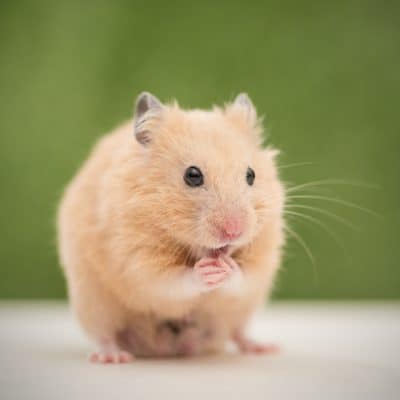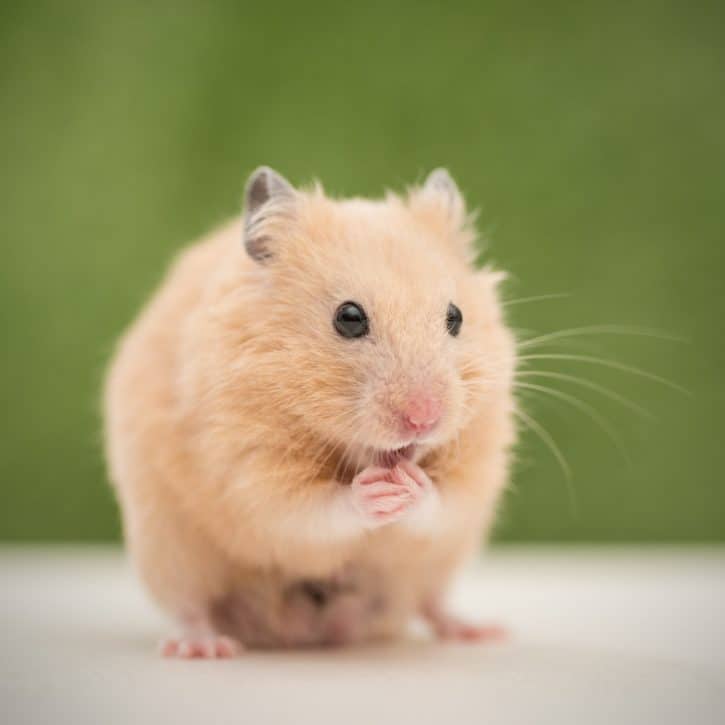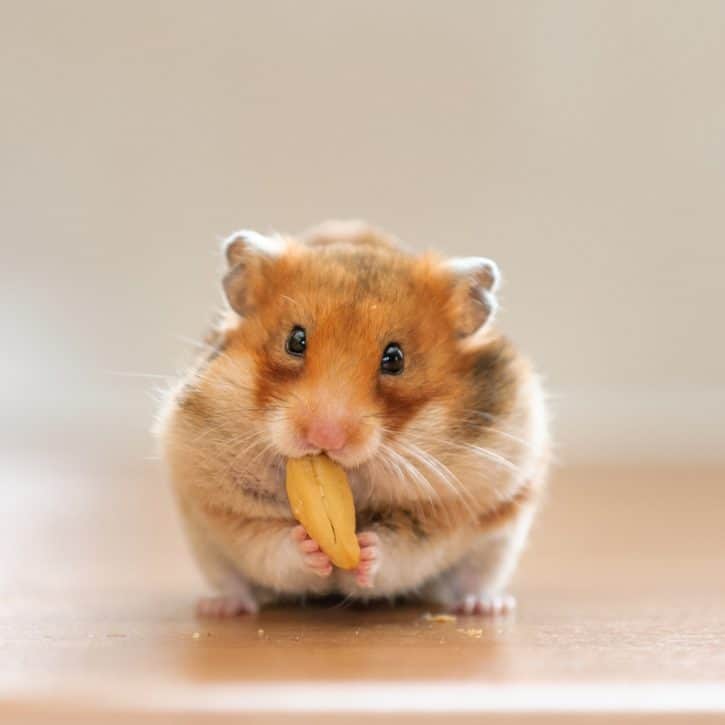What Do Hamsters Eat?
May 21, 2020April 24, 2019 by C.B. Daniels


The Short Answer: While hamsters will eat almost anything, they should be fed a diet of pellets that is marginally supplemented with cereals, grains, fruits, vegetables, and meats.
Now let’s look at some more detailed information about hamsters and their diets.
Contents
2.1 How Do Hamsters Get Their Food?
2.2 What Do Baby Hamsters (Pups) Eat?
2.3 What Do Adult Hamsters Eat?
3 How Often Should You Feed Hamsters?
4 Summary of What Do Hamsters Eat
What Are Hamsters?
Hamsters are rodents which are mammals from the order Rodentia. This order is the largest order of mammals (warm-blooded animals with hair or fur that have backbones and whose females produce milk) and includes mice, rats, gerbils, chipmunks, squirrels, and chinchillas.
There are many types of hamsters, but the one that is most commonly kept as a pet is the Syrian hamster (also known as a golden hamster or teddy bear hamster).
The second most commonly kept pet hamster is the dwarf hamster which has three species: the Campbell’s dwarf hamster, the winter white dwarf hamster, and the Roborovski dwarf hamster (also known as a Robo dwarf hamster).
Hamsters are well-known for their small, furry bodies and adorable cheeks, and are often one of the first pet choices for children. Although, many adults love having hamsters as well!
Hamsters can live anywhere from 2-8 years in captivity (although 2-4 years is the average) and range in size from 13 inches (the European hamster) to 2 inches (the dwarf hamster). Syrian hamsters are typically around 5-7 inches long.
What Do Hamsters Eat?
Contrary to popular belief, hamsters are not herbivores who only eat plants. Instead, they are omnivores which means they eat both plants and meat.
Hamsters are also foragers which means that they travel to look for their food. In the wild, hamsters will eat almost anything they come across which includes a variety of seeds, grains, cereals, grasses, vegetables, fruits, and meats.
Fun Fact: Hamsters in the wild have even been known to hunt in packs to bring down insects, small lizards, or even frogs!
Thankfully, your pet hamster doesn’t have to do all that.
Instead, you can provide a perfectly balanced diet by feeding your hamster commercial hamster pet food. There are two main types of commercial hamster food: muesli and pellet.
Muesli pet food typically contains a loose mixture of seeds, nuts, cereals, grains, and vegetables, and pellet pet food typically contains the same but is in a combined hardened form. Pellets are also sometimes called rodent blocks.
Even though they seem similar, pellets are often recommended over muesli pet foods.
This is because hamsters will often pick out and eat only what they want when given muesli-style food (often the high-fat seeds that they love). This can lead to a nutrient deficiency, so pellets are a way to avoid this problem.
Also, it’s important to choose the least colored variety of pet food, because the extremely colorful varieties are often full of chemicals and additives that are not good for hamsters’ digestion.
How Do Hamsters Get Their Food?
As mentioned previously, hamsters forage for their food.
Hamsters also practice food caching (also known as hoarding) which is where they hide their food to prevent competitors from eating it.
Fun Fact: The word hamster comes from the German word hamstern which means “to hoard.”

Even though your pet hamster (hopefully) has no predators at your house, they will still engage in this behavior and often hid their food under their bedding. Hamsters can become very stressed if not given enough hiding places so always provide several options for them!
Hamsters gather their food into their cheek pouches which are pockets just behind their front teeth that can stretch behind their shoulders. They can store quite a lot in these pouches, and then hide their food to eat later at their convenience.
As for how they eat, hamsters have very strong teeth that never stop growing. They are born with 16 teeth which they keep for their whole life and never replace.
Since their teeth grow continuously, it’s important to provide your hamster with lots of chew toys such as wooden logs or blocks. Otherwise, they will start to chew on their cage and food containers.
Also, be aware that hamsters also practice coprophagy which is just a fancy term that means they eat their own feces so that they can recover more nutrients!
What Do Baby Hamsters (Pups) Eat?

Baby hamsters are called pups and have a slightly different diet than adult hamsters do.
As many a surprised hamster owner has found out, hamsters are very good at breeding! If you keep a male and female hamster together, you will probably end up with pups.
Fun Fact: A male hamster is called a boar, and a female hamster is called a sow.
Hamsters typically breed in the spring and summer, and female hamsters can produce several litters a year. The average litter size is around seven pups.
A female hamster’s gestation period is only 15-20 days, and when born, pups are blind and cannot open their eyes until they are around two weeks old (but hey they already have their 16 teeth!).
Since they are mammals, pups drink their mother’s milk. After about 3-4 weeks they start to be weaned onto solid food. Hamsters can be weaned with soft food first (such as bread or cooked vegetables), and then they can slowly progress onto pellet food.
If the pups are having difficulty with pellets, you can always soften them with water to help them be able to eat and digest them.
What Do Adult Hamsters Eat?

As mentioned before, adult hamsters will eat almost anything but should be fed a diet of pellets.
This diet should also be marginally supplemented with cereals, grains, fruits, vegetables, and meats, and these foods should make up no more than 10% of your hamsters’ diet and should be rotated.
For example, one time give your hamster meat and vegetables and another time you give your hamster fruits and cereals.
An average portion size for these other foods is one small cube about the size of two raisins.
It is incredibly important to portion control your hamster’s food because hamsters (especially dwarf hamsters) are prone to obesity and diabetes. When given the opportunity they will almost always overeat, so it’s your job to monitor their food for them!
The average portion of dried pellet food is one tablespoon per hamster.
This, of course, depends on your hamster’s age and size, so always follow the instructions on the food bag or ask your veterinarian for instructions.
Fun Fact: Even though they are different sizes, Syrian and dwarf hamsters eat almost the same amount of food because dwarf hamsters have a higher metabolism.
Also, some foods are bad for hamsters such as citrus fruits, onions, eggplants, or chocolate. Many (but not all) seeds, skins, and pits are also bad for them, so when in doubt, remove these.
Always wash any fruits and vegetables to remove pesticides and cut them up to help prevent choking.
Hamster Food Options
Here are some hamster food options that are broken down by category:
Fruits
Apples (remove seeds)
Bananas
Blackberries
Blueberries
Cantaloupes
Cherries (remove pits)
Cranberries
Grapes (seedless)
Mangos
Peaches (remove stone)
Pears
Plums (remove pits)
Raspberries (raspberry leaves can help with diarrhea in hamsters)
Strawberries
Meats/Proteins
Beef (cooked)
Chicken (cooked)
Crickets
Grasshoppers
Hardboiled eggs (can also be scrambled)
Meal Worms
Turkey (cooked)
Vegetables
Asparagus
Bean Sprouts
Bok Choy
Broccoli
Cabbage
Carrots
Cauliflower
Celery (remove strings to prevent choking)
Chard
Cucumbers
Kale
Okra
Parsnips
Peas
Radicchios
Romaine Lettuce
Spinach
Squash
Sweet Potatoes (remove the skin)
Turnips
Zucchini
DO NOT Feed Hamsters
Acorns
Almonds
Chocolate
Citrus Fruits
Eggplant
Garlic
Onions
Peanuts
Raw Kidney Beans
Raw Potatoes
Tomatoes
Watermelons
How Often Should You Feed Hamsters?
Since hamsters are crepuscular (which means they are most active during twilight hours), they will often eat at dawn or dusk.
However, they do often wake up during the day to snack and can eat at almost any time. Many people feed their hamsters either twice a day or once a day.
More important than how often you feed your hamster is consistency with whatever schedule you choose. Hamsters naturally want to have a lot of food available, and inconsistent feeding will make them overeat.
Also, never leave uneaten fruits, vegetables, or meat for over 24 hours because they will start to rot, which can cause stomach problems for your hamster.
Hamsters should be provided with clean water daily in either a bowl or water bottle (or both), and these should be cleaned weekly. If your tap water is high in chlorine, it is best to give your hamster filtered water.
Summary of What Do Hamsters Eat

While hamsters will eat almost anything, they should be fed a diet of pellets that is marginally supplemented with cereals, grains, fruits, vegetables, and meats.
Hamsters are omnivores (they eat both plants and meat) that forage (they travel for their food).
You should feed hamsters pellet food over muesli food so that they have a more nutritionally balanced diet.
Hamsters also practice food caching (also known as hoarding), so it’s important to provide your hamster with plenty of hiding places to store food. They do this by putting food in their cheek pouches (which are pockets just behind their front teeth that can stretch behind their shoulders) and then storing the food when they find an appropriate spot.
Baby hamsters are called pups, and they drink their mother’s milk until they are about 3-4 weeks old. Then they can start to be weaned onto solid food such as bread or cooked vegetables. Eventually, they will eat pellet food like adult hamsters do.
Additional foods (that are not pellets) like cereals, grains, fruits, vegetables, and meats should make up no more than 10% of your hamster’s diet and should be rotated.
An average portion size for these other foods is one small cube about the size of two raisins, and the average portion of dried pellet food is one tablespoon per hamster.
You should always wash fruits and vegetables to remove pesticides and cut them up to prevent choking.
Also, some foods are bad for hamsters such as citrus fruits, onions, eggplants, or chocolate. Many (but not all) seeds, skins, and pits are also bad for them, so when in doubt, remove these.
Since hamsters are crepuscular (active at dawn and dusk), they will often eat during these times. However, you can choose to feed your hamster at any time if you are consistent with their schedule.
Never leave uneaten food for over 24 hours because it will rot, and always provide fresh water daily for your hamster.
Other articles you might be interested in:
Hi my name is C.B. Daniels and I make websites. I’ve also always been fascinated by animals. I thought that some of the information about animal diets and pet names was a little thin. So I figured I’d make this site to remedy that! I hope to make this site a hub for information about what animals eat, fun names you can use for your pets, and general animal information. Hopefully, you’ll find all the information about animals you are looking for and much more!
Latest posts by C.B. Daniels (see all)
- Can Rabbits Eat Grapes? - November 12, 2022
- Can Rabbits Eat Cucumbers? - November 3, 2022
- Can Rabbits Eat Spinach? - November 3, 2022